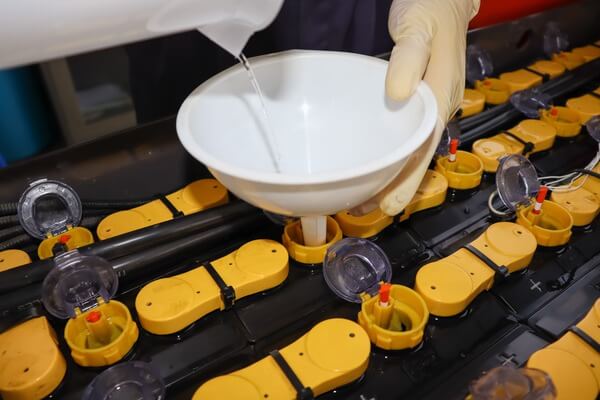
Are you wondering what opportunity charging is?
Then you’re in luck.
Because this article will explain everything you need to know about opportunity charging, including:
- What opportunity charging is
- The pros and cons of opportunity charging
- The difference between conventional, opportunity, and fast charging
- How to tell if opportunity charging is right for you
- And much more!
Let’s dive in!
Opportunity chargers for forklifts are specialized chargers that use high current to quickly charge batteries to an 80-85% state of charge (SOC).
Why Is it Called “Opportunity” Charging?
It’s because opportunity charging involves charging a battery when time is available within a shift.

This often means during shift changes, breaks, and lunches.
What Are the Specifics of Opportunity Charging?
The specifications of opportunity charging are:
- Battery charge time: 30 minutes + weekly full equalization charge
- Total time to charge the battery: 4-6 hours (total throughout the day)
- Total charge level: 80-85% SOC to limit battery gas generation
- Battery charging rate: 25 amps per 100 amp-hours
Additionally, the battery should be charged to 100% once per shift, usually overnight.
Advantages of Opportunity Charging
Boosts Productivity
Opportunity charging can be done during downtime.
This helps maximize productivity by eliminating the need for operators to take time for unscheduled charging.
Saves Time
Opportunity charging means operators don’t need to swap out batteries.

Therefore, they can devote more time to their job duties instead of the time-consuming activity of swapping batteries.
Improves Safety
Swapping batteries involves the risk of injury.
But opportunity charging eliminates the need to swap batteries.
So, operators have less risk.
Saves Storage Space
Storing extra batteries requires space.
And that space, of course, comes at a cost.

But with opportunity charging, you don’t need that extra space, since you don't need extra batteries.
Therefore, you can save money by eliminating battery storage areas.
Disadvantages of Opportunity Charging
Challenge in Staff Consistency
Taking full advantage of opportunity charging falls on forklift operators.
That’s because it’s up to them to be proactive and consistent with charging their batteries during breaks and other downtimes.
But if your operators aren’t consistent, you won’t reap the full benefits of opportunity charging.
Reduces Battery Lifespan
Battery lifespan has an inverse relationship with charging.
In other words, the more often you charge the battery, the faster it will wear out.

And because opportunity charging requires frequent charging, you’ll reduce the effective lifespan of your battery.
Of course, this can prove costly in the long run.
Requires an Equalize Charge
Opportunity charging doesn’t let you off the hook when it comes to equalization charging.
Not sure what that means?
It’s simply a weekly charge that helps level out the battery and reduces the chances of battery sulfation.
With opportunity charging, you’ll still need to equalize the battery once per week.
More Battery Maintenance
Frequent charging will reduce the amount of electrolyte in your battery through gassing.
As a result, your batteries may require more maintenance, especially battery watering.

And this can add to your operational costs.
Warranty Issues
Opportunity charging can be tough on a battery.
That’s why some manufacturers may stipulate that, in case of battery damage, opportunity charging will void the warranty.
Thus, if maintaining your battery warranty is important, you should check with the manufacturer to see if it voids the warranty.
Your electric forklift is only as good as its battery and charger system.
But are all forklift chargers the same?
No.
Electric forklifts don’t have a “one size fits all” battery and charger system.
There are different types of lead-acid battery charging methods.
The 3 main types of battery charging are:
- Conventional charging
- Opportunity charging
- Fast charging
Now, we’ve already covered opportunity charging.
So let’s go through the other two methods to see how they compare.
Conventional Charging
Conventional charging is the normal lead-acid battery charging method.

It’s typically done after a work shift, usually overnight, and uses a low current.
What Are the Specifications for Conventional Charging?
Here are the specifications of conventional charging:
- Time to charge: 8-10 hours + weekly equalization charge
- Charge level: 100% SOC
- Charging rate: 16-18 amps/100 amp-hours
- Cooling time: 8 hours after charging and before using the battery again
Advantages of Conventional Charging
- Maintains the battery’s health because of slow and steady charging and time for cooling
- Best for the battery’s longevity because it uses fewer battery cycles
Disadvantages of Conventional Charging
- Not ideal for extended or multi-shift operations
- It takes longer (8-10 hours) to charge the battery and extended time to allow the battery to cool down
- Greater safety risk because of the need to swap batteries
- It requires more labor, more time, and exposes workers to the risk of injury during battery handling
- Because of longer charging hours, hydrogen release, and depletion of electrolytes, it has environmental concerns
- For better productivity, you’ll need to purchase at least two batteries per forklift truck
Fast Charging
Fast charging is similar to opportunity charging, except it uses a higher charge rate.
What Is the Difference Between a Fast Charger and a Normal Charger?
Wondering how do fast chargers work?
A fast charger is a special, dedicated battery charger with faster start rates, usually 40+ amps per 100 amp-hours.
This charging rate is 3 to 4 times that of a normal (conventional) charger.
Is Fast Charging Bad for a Battery?
Yes.
Fast-charging is extremely hard on a battery’s overall life.
When you compare fast charging vs. normal charging battery life, fast charging can reduce battery life by 30%.

This is because of the higher charging rate and the need to frequently charge the battery.
As a result, the battery’s life cycles are used up more quickly.
And so you may have to replace the battery more often.
What Are the Specifications for Fast Charging?
The specifications of fast charging include:
- Time to charge: 2-3 hours total charging throughout the day
- Charge level: Charging stops at 80-85% SOC
- Charging rate: 40+ amps per 100 amp-hours (3-4x greater than conventional charging)
- Equalization charge: Once per week + 100% full charge once per week
Advantages of Fast Charging
- Lower risk of injury because there’s no need to swap batteries
- Reduces downtime related to battery charging and improves productivity
- No need for costly extra batteries
- No need for battery storage areas
Disadvantages of Fast Charging
- Extremely hard on the overall battery life
- May void battery warranty
- The battery may need replacement more often because of increased use and decreased life cycles
Now, we’ve covered 3 different forklift battery charging methods.
So you’re probably wondering: How do I choose a forklift battery charger?
Knowing which type of charging will work for you first depends on the demands of your operation.
The Best Charging Methods by Operational Demands
For different shift arrangements, the best charging methods are as follows:
- Conventional charging: Best for single-shift operations
- Opportunity charging: Best for two-shift operations, long single shifts, or extended use operations
- Fast charging: Best for 3-shift, heavy use, and continuous use operations
How Much Can Opportunity Charging Save You?
The other factor in determining if opportunity charging is right for you is how much money it can save you.
So what's the answer?
Let's go through an example to see.
First, let’s make a few assumptions:
- You're running a 2-shift operation 24/7/365
- You're using 20 total 3-wheel electric forklift trucks
- It takes about 30 minutes to swap out batteries
- Your forklift operators are paid $20 per hour
The Cost of Conventional Charging
Now, with a conventional charging setup under these conditions, you’ll need one charger per truck.
That means you’ll need 20 total chargers.
At $2,200 each, that would mean spending $44,000 on chargers.
Also, you would need 40 batteries total for conventional charging.
That is, 2 batteries per truck with both batteries used during each of the 2 shifts.
And that would cost you $200,000 ($5,000 per battery x 40 batteries).
Furthermore, you’ll need to account for the labor costs associated with swapping batteries.
At one swap per shift, the cost is $10 in labor (30 minutes to swap x $20 per hour wage).
Multiplied by 40 swaps per truck every day for 365 days, you’ll spend $146,000 each year in labor.
Now, let’s summarize the costs of conventional charging:
- Cost of chargers: $44,000
- Cost of batteries: $200,000
- Cost of battery swaps: $146,000
The Cost of Opportunity Charging
Instead of conventional chargers, you’ll need to buy opportunity chargers.
And these are a bit more expensive at around $2,800 per charger.
Given that you’ll need one charger per truck, the cost for all new chargers will be $56,000 ($2,800 x 20).
Now, you’ll still need 20 batteries for each of your trucks.
But fortunately, with an opportunity charging setup, you won't have to buy an extra battery per truck.
That’s because opportunity charging lets you get by on a 2-shift operation with a single battery.
So, you would save $100,000 on the cost of extra batteries ($5,000 x 20).
But that’s not all.
Because you won’t have to swap batteries with opportunity charging, you’ll also save on labor costs.
Using the calculation from the last section, that means you’ll save $146,000 each year in labor.
Now, let’s summarize the costs of opportunity charging:
- Cost of chargers: $56,000
- Cost of batteries: $100,000
- Cost of battery swaps: $0
Potential Savings Using Opportunity Charging
Let’s compare the costs from the previous two sections to see how much you can potentially save by using an opportunity charging setup:
Expenditures
Chargers
Batteries
Battery Swaps
Total Costs
Conventional Charging
$44,000
$200,000
$146,000
$390,000
Opportunity Charging
$56,000
$100,000
$0
$156,000
As you can see, opportunity charging can certainly save your operation lots of money.
But of course, the savings will depend on your circumstances.
And there’s also the fact that you’ll need to replace your batteries sooner with opportunity charging.
Because of these factors, we recommend contacting us to determine what your actual savings could be by switching to opportunity charging.
Conclusion
There you have it: Everything you need to know about opportunity charging.
Now, it’s your turn.
Can you determine if opportunity charging is the right battery charging method for you?
Do you have any further questions?
Please share with us in the comments section.









